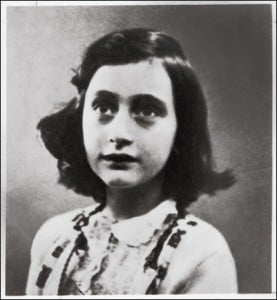
Image from http://annefrankbiography.com/
I was introduced to the Holocaust in 7th grade. Like many middle school students, I was given a window into the horrors of the Nazi “round ups” through reading the Diary of Anne Frank.
My long-time interest in Anne’s story was rekindled last weekend when I had the honor of meeting with Hannie Voyles, a schoolmate of Anne Frank’s. Hannie’s story of survival under five years of Nazi occupation of the Netherlands is every bit as compelling as Anne’s story. It is my hope that Hannie will soon share her story beyond her community (Chico, California). I just finished watching footage from a recent interview she did with a group of 8th grader peer mediators from Chico’s Marsh Jr. High. While Anne Frank was hidden away, Hannie and her sister were out on the streets everyday in the eye of the storm.*
Teaching the Holocaust requires having age-appropriate resources. I was initially taken aback when I discovered that the Open Court Reading Program includes a piece about Anne Frank in the 4th grade anthology. However, in working with several 4th grade classes (in my role as coordinator of my district’s EETT grant), I have come to see that elementary students are quite capable of delving into complex social issues that span communities and generations. If the materials and the manner in which the topic is introduced are age-appropriate, 4th graders are ready for and capable of joining in meaningful shared conversations on tough topics.
Through my participation in the National Writing Project’s Holocaust Educator’s Network, I’ve accumulated a variety of resources for teaching about genocide in general and the Holocaust in particular. After meeting with Hannie Voyles, I am now seeking resources that best tell the impact of Nazi occupation on school-age children and their families and that provide insights into the topic of resiliency of the human spirit. Anne Frank’s story will be my starting point.
Here’s what I have so far:
- Film footage of Anne Frank – Filmed in celebration of a neighbor’s wedding in July of 1941, shortly before the Frank family went into hiding, this is the only footage of Anne Frank.
- We Remember Anne Frank – Scholastic’s unit includes interviews with Miep Gies, the loyal employee of the Frank family. Lessons are arranged by grade level, starting with grade 3.
- Anne Frank, Writer – From EDSITEment (National Endowment for the Humanities), this site scaffolds their lessons and provides resources for connecting Anne’s story to other examples of racism and exclusion.
- Anne Frank – Lessons in Humanity and Dignity – Provides activities for school and home.
- Anne Frank Received Her Famous Diary in 1942 – From ReadWriteThink!, the unit introduces students to the importance of first-hand accounts in understanding historical events.
- Diary of Anne Frank, the movie – PBS provides a Teacher’s Guide to accompany the DVD (which you can order from the site). The site also includes the Take Action page, a listing of projects and activities for empowering students to make a difference. In the current test-driven climate, all too often the reading of powerful stories ends with the “what,” and students are not moving on to explore the next two components, so essential to meaningful learning: “so what” and “now what.”
- Anne Frank Timeline – Part of the Secret Annex Online site, the timeline provides background and compelling images from Anne’s story, starting in 1914.
* May 2011 Update:
- Anne Frank the Writer: An Unfinished Story – From the United States Holocaust Memorial Museum, the resources include a beautifully done tour of Anne Frank’s diary through images and audio clips.
- Beyond Anne Frank.pdf – Created by Jennifer Norton, Regional Education Corps Member, United States Holocaust Memorial Museum, to complement reading of The Diary of Anne Frank.
- The Danish Solution – From Snag Learning, this documentary film is a tribute to the “upstanders” of Denmark. It details how the Danish were able to save many of Denmark’s Jewish population when the Nazi’s Final Solution was implemented. There are even discussion questions on the page, but thanks to Holocaust Educators Network (HEN) educator Diane Williams, here are two more thought-provoking, guiding questions:
- What inspires us to act? or Why act? (I think this is a question that gets to the root of what my students have grappled with over the years when studying the Holocaust – why did some act and some did not?) This also allows them to look at fear as a motivator, principles, religious beliefs, humanitarian reasons.
- What forms of resistance are the most effective? When and Why?
- An Interview with Hannie Voyles – Coming soon!! A year after first meeting Hannie, I traveled with videographer Doug Niva to Chico, California, to record an interview with Hannie. We hope to have video clips from the interview online within the next few weeks. The interview will be a wonderful resource to accompany her newly released Storming the Tulips, “A tightly-knit connection and complement to Anne Frank’s story.“
If you have Anne Frank resources to add to the list, I hope you will post a comment. My goal is, over the summer, to develop a unit on name calling that could be used across grade levels and would help students make connections and comparisons between what was “then and there” (the Holocaust) to what is “here and now.”

Pingback: Remembering Anne Frank: An Update | BlogWalker